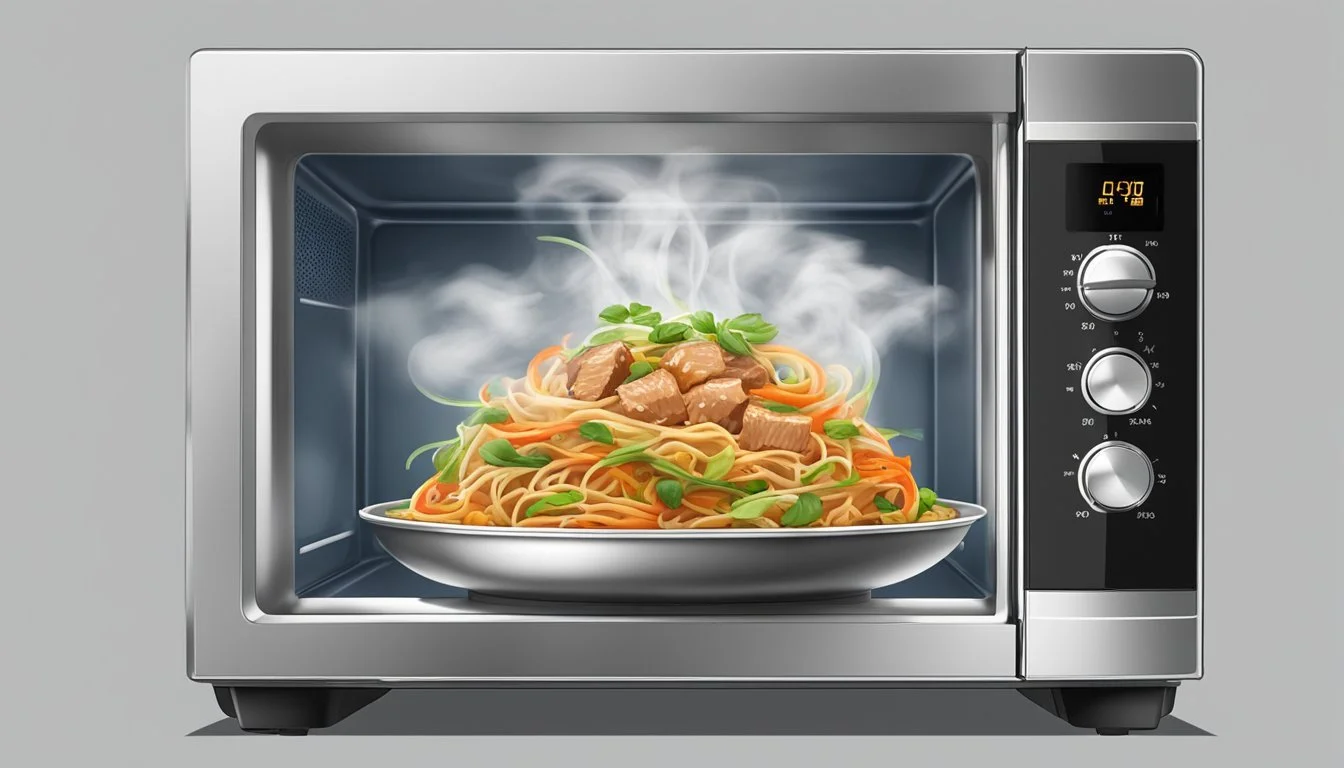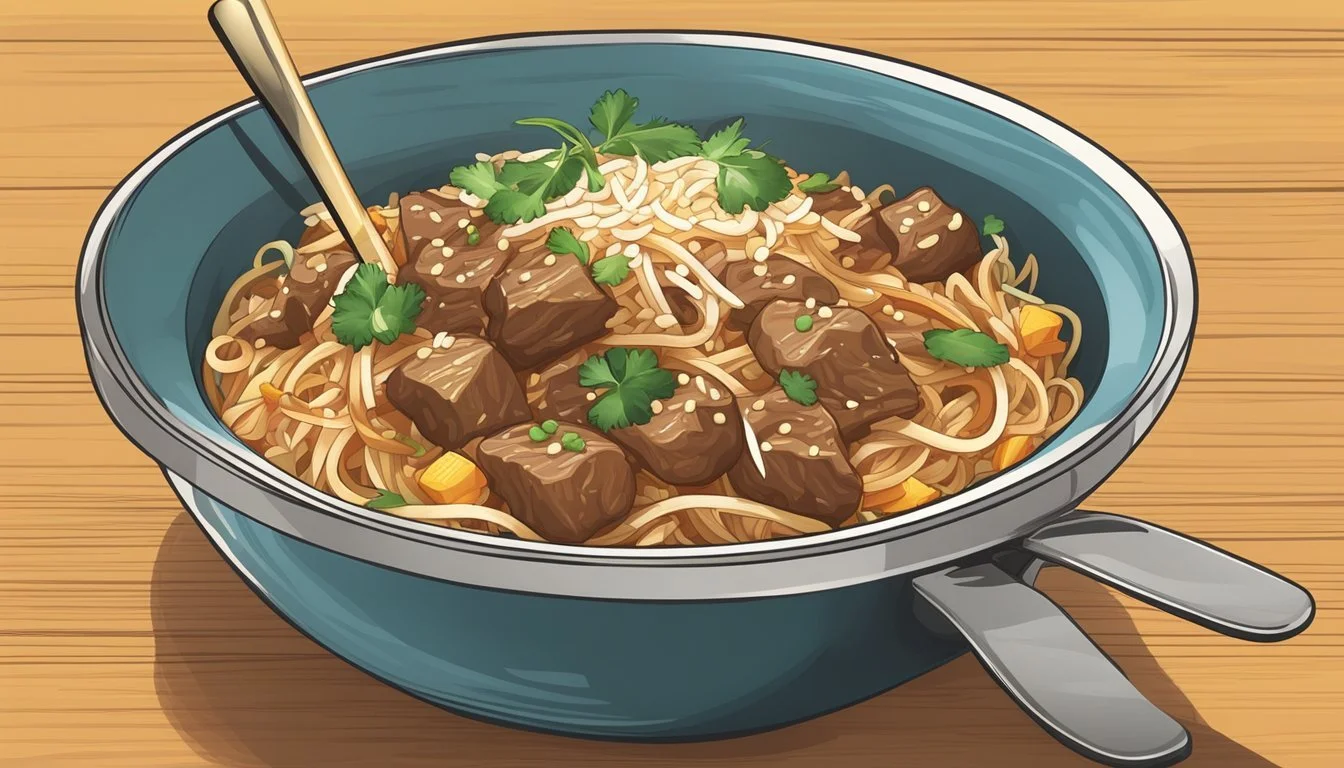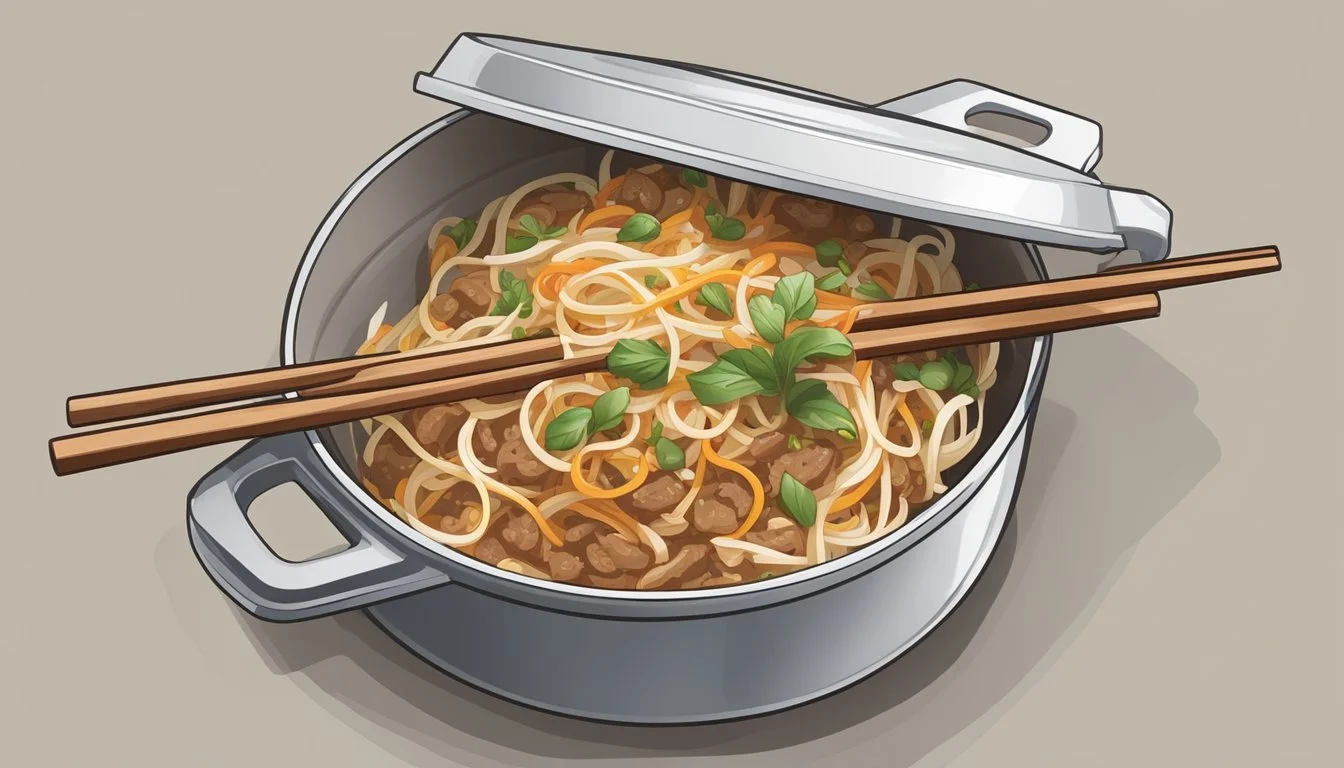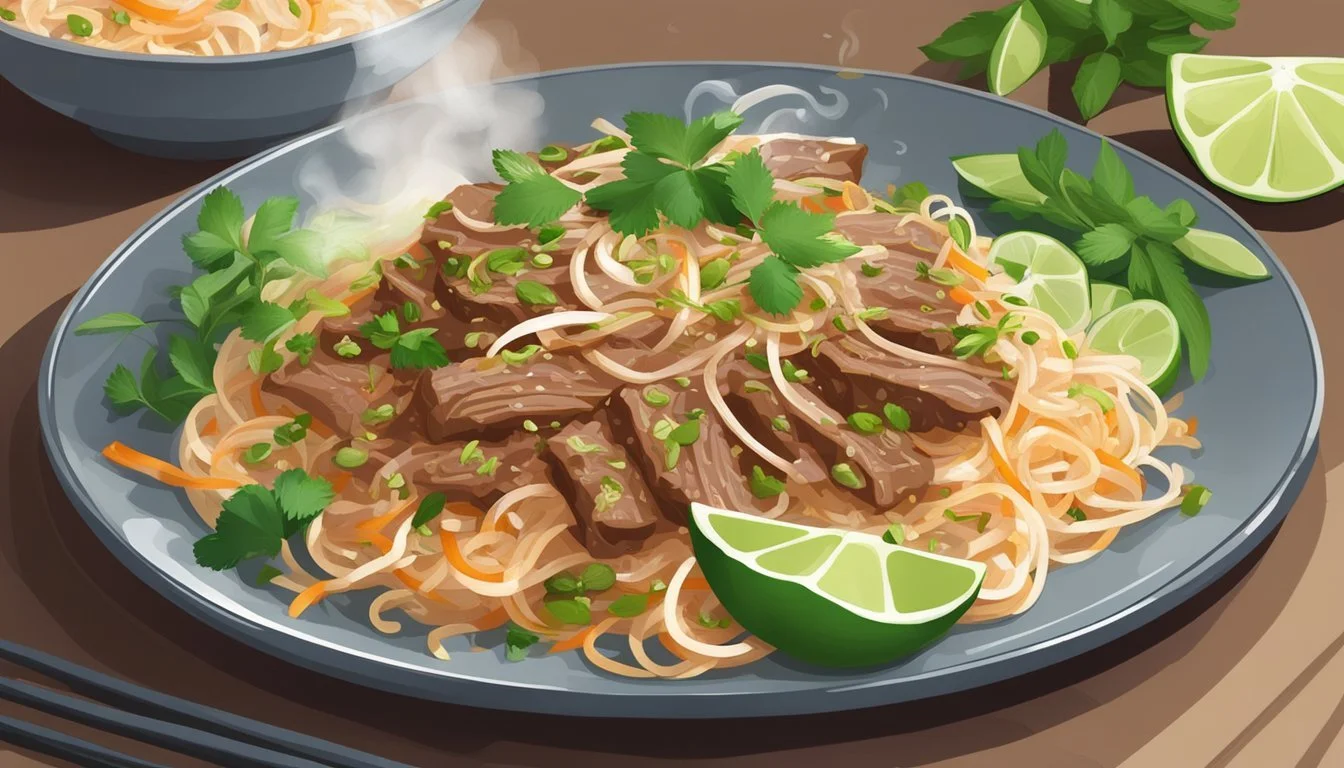How to Reheat Beef Pad Thai
Best Methods for Delicious Results
Reheating beef Pad Thai can be a challenge if you're aiming to maintain its original texture and flavor. The best method to reheat leftovers without drying them out is by using the stovetop with a little oil for even heating. This approach helps to preserve the dish's savory components, such as the tender beef and chewy noodles.
Using an oven can also be effective. Preheat the oven to 350°F and spread the Pad Thai out on a baking sheet, adding a touch of water to keep the noodles moist. Covering the dish with foil prevents it from drying out. This method ensures that the flavors meld beautifully as they warm up.
For a quicker fix, the microwave works well, especially if you're in a hurry. Place the Pad Thai in a microwave-safe container, cover it loosely, and heat it in short intervals, stirring in between to ensure even warming. This method keeps the dish ready to eat within minutes, retaining its delicious taste.
Understanding Pad Thai
Pad Thai is a staple of Thai cuisine, renowned for its balanced flavors and complex textures. For those looking to enjoy this dish at its best, understanding its key components is essential.
What Is Pad Thai
Pad Thai is a popular Thai street food made with stir-fried rice noodles. It's a delightful combination of sweet, sour, salty, and umami flavors. The dish traditionally includes elements such as shrimp, chicken, or tofu, making it versatile for various dietary preferences.
The sauce usually comprises tamarind paste, fish sauce, and palm sugar, creating its distinctive taste. It's often garnished with crushed peanuts, bean sprouts, and lime wedges, adding crunch and freshness.
Components of Beef Pad Thai
Noodles: The dish uses rice noodles, which are soaked before cooking. They are stir-fried until soft yet chewy.
Sauce: The Pad Thai sauce is the cornerstone, featuring tamarind paste for tanginess, fish sauce for saltiness, and palm sugar for sweetness. When adding beef, the sauce's robustness complements the meat well.
Vegetables: Common vegetables include bean sprouts, green onions, and sometimes bell peppers. These add freshness and a slight crunch.
Protein: In Beef Pad Thai, sliced beef is used, often marinated to enhance flavor. This protein blends harmoniously with the other ingredients.
Egg: An egg is typically cooked in the same pan, incorporating into the noodles to provide additional texture and richness.
Garnishes: Finally, crushed peanuts, lime wedges, and fresh cilantro are added for garnish, contributing to the dish’s flavor and presentation.
Pre-Reheat Preparation
Ensuring the best results when reheating beef pad Thai involves assessing its quality and properly thawing it if frozen. These steps help maintain flavor and texture.
Assessing Leftover Pad Thai Quality
Before reheating, it's essential to evaluate the quality of the leftover pad Thai. Examine the noodles, beef, and vegetables for any signs of spoilage, such as off odors, discoloration, or slimy textures. Pad Thai stored in the refrigerator typically has a shelf life of 3-4 days. For optimal safety and quality, avoid reheating any leftovers that have been sitting longer than this duration. If you notice any spoilage signs, it is better to discard the leftovers to prevent foodborne illnesses.
Thawing Frozen Pad Thai
If the pad Thai has been stored in the freezer, proper thawing is crucial. Transfer the frozen pad Thai from the freezer to the refrigerator, allowing it to thaw slowly for several hours or overnight. This slow thawing process helps maintain the dish's texture and reduces the risk of bacterial growth. If you're in a hurry, you can use a microwave. Place the pad Thai in a microwave-safe container and use the defrost setting, stopping to check and stir every minute until evenly thawed. Never thaw pad Thai at room temperature, as it can lead to uneven thawing and potential spoilage.
Selecting the Right Reheating Method
Reheating beef Pad Thai to maintain its original taste and texture requires choosing the most suitable method. Here are several methods with step-by-step instructions to ensure your meal comes out perfect.
Microwave Method
Reheating beef Pad Thai in the microwave is the fastest option, ideal for those short on time. Begin by placing the Pad Thai in a microwave-safe container. Cover the container loosely with a lid or plastic wrap. This prevents the noodles from drying out. Microwave in 30-second intervals, stirring in between to ensure even heating. Repeat until the dish is heated thoroughly. Add a splash of water or a teaspoon of oil if the noodles appear dry. This method is convenient, but some may find it less tasty than other options due to the potential for uneven heating.
Stovetop Method
The stovetop method provides more control over heating, resulting in a texture closer to freshly cooked Pad Thai. Begin by adding a small amount of oil to a pan over medium heat. Once the oil is hot, add the beef Pad Thai, breaking up any clumps. Stir frequently to ensure even heating and prevent sticking. It helps to add a tablespoon of water or broth to rejuvenate the noodles and prevent them from becoming too dry. Within 5-7 minutes, the dish should be evenly heated and ready to serve. This method is slightly longer but ensures a better texture and taste.
Oven Method
Reheating beef Pad Thai in the oven is a less common but effective method, especially for large portions. Preheat the oven to 350°F (180°C). Spread the Pad Thai evenly on a baking tray, adding a tablespoon of water or broth per serving to keep the noodles moist. Cover the tray with aluminum foil to prevent drying out. Bake for 10-15 minutes or until the dish is heated through. This method is less convenient due to the preheating and longer cook time but offers more consistent results for retaining the dish’s original flavors and textures.
Air Fryer Method
Using an air fryer to reheat beef Pad Thai is a novel approach that combines the best of both speed and flavor. Preheat the air fryer to 350°F (175°C). Place the Pad Thai in the air fryer basket, ensuring it is spread out evenly. Avoid overcrowding to ensure even heating. Heat for 5-7 minutes, shaking the basket halfway through to mix the noodles. The hot, circulating air reheats the dish quickly and helps maintain its texture. This method is efficient but requires careful monitoring to avoid drying out the noodles.
Step-by-Step Reheating Instructions
Reheating Beef Pad Thai can be simple and effective when you follow the right methods. These instructions focus on retaining flavors and texture while ensuring even heating.
Reheat Pad Thai in the Microwave
To reheat Pad Thai in the microwave, start by placing the leftovers in a microwave-safe dish. Microwave the dish for 30 seconds. This will loosen up the noodles, making it easier to spread them out without breaking.
Next, cover the dish with a damp paper towel to maintain moisture. Microwave on medium heat for 1-2 minutes, stirring halfway through to ensure even heating. If the noodles seem dry, add a tablespoon of water and continue heating.
Reheat Pad Thai on the Stove
For reheating on the stove, use a skillet or wok. Preheat the skillet over medium heat and add a little oil. Once the oil is hot, add the Pad Thai and spread it out evenly.
Stir or toss the Pad Thai continuously for about 3-5 minutes. This method helps to redistribute the oil and moisture, keeping the noodles soft. Avoid overcrowding the pan to ensure even heating.
Reheat Pad Thai in the Oven
Begin by preheating the oven to 350°F (180°C). Place the Pad Thai on a baking sheet or an oven-safe dish. For best results, add a tablespoon of water per serving to maintain moisture.
Cover the dish with foil and heat in the oven for 7-10 minutes. Check after 5 minutes to ensure it is heating evenly and to avoid drying out the noodles. This method is perfect for evenly reheating larger portions.
Reheat Pad Thai in the Air Fryer
To use an air fryer, preheat it to 370°F (188°C). Place the Pad Thai in an air fryer-safe dish or tray. A lower temperature for a longer duration helps keep the noodles from getting crunchy or dry.
Set the timer for 8 minutes and check halfway through to stir and ensure even heating. This technique is great for a quicker option while still keeping the noodles soft and flavorful.
Optimizing Taste and Texture
When reheating beef pad Thai, it is crucial to maintain the dish's original flavors, moisture, and texture. Focus on preventing overcooking, sustaining the right moisture level, and integrating fresh ingredients.
Preventing Overcooking
Overcooking can make the noodles and beef tough. Choose reheating methods that use moderate, controlled heat. Microwaves should be set to medium power, heating for short intervals of 1-2 minutes. Stir occasionally to distribute the heat evenly and avoid hotspots.
For oven reheating, preheat to 350°F (175°C). Place the pad Thai on a baking sheet, cover with foil, and check after 5-7 minutes. Stirring midway through can prevent overcooking and ensure even heating.
Maintaining Moisture
Retaining moisture in beef pad Thai is vital to avoid drying out the noodles and beef. Adding a splash of liquid like water, broth, or a mix of lime juice and fish sauce can help. Place the beef pad Thai in a microwave-safe dish and cover it with a damp paper towel or plastic wrap, leaving a slight vent.
In the oven, spreading the pad Thai on a baking sheet and covering it with foil can trap steam. The added moisture prevents the noodles from becoming dry and retains the dish's rich, savory flavors.
Adding Freshness and Flavor
Enhancing the reheated dish with fresh ingredients can revitalize its flavor profile. Sprinkle fresh cilantro, chopped green onions, or a squeeze of lime juice just before serving. These additions bring a burst of freshness and vibrancy to the reheated dish.
Adding extra seasonings such as a dash of soy sauce, fish sauce, or ground spices can boost the flavors. Vegetables that might have lost their crispness can be quickly sautéed and mixed back in. Enhancing the dish with crushed peanuts or a touch of sriracha can add texture and heat, making your reheated beef pad Thai taste restaurant-fresh.
Proper Storage Techniques
To keep your beef pad Thai fresh and safe for consumption, follow appropriate storage methods. These practices will help maintain the taste and quality of the dish, whether refrigerated or frozen.
Storing Reheated Pad Thai
When storing reheated beef pad Thai, it is essential to use the right containers. Airtight containers are crucial to prevent drying out and contamination. Place the leftover pad Thai in a container and seal tightly.
Store it in the refrigerator at or below 40°F to avoid spoilage. Make sure to consume the leftovers within 3-4 days to ensure food safety. If you notice any strange odors or textures, it's best to discard the dish.
Freezing and Thawing Techniques
For longer storage, freezing is an effective option. To freeze pad Thai, divide it into portion sizes and place the servings in airtight freezer-safe containers or heavy-duty freezer bags. Label each container with the date to keep track of its freshness.
When ready to eat, thaw the frozen pad Thai overnight in the refrigerator. This slow thawing method helps retain the dish's texture and flavor. For a quicker option, use a microwave on the defrost setting, but be careful to monitor frequently to avoid overcooking.
Dish Enhancements and Variations
Reheating beef Pad Thai is an opportunity to enhance its flavors and introduce new variations. Simple adjustments and thoughtful ingredient choices can transform this popular Thai dish into a fresh and delicious meal.
Customizing Reheated Pad Thai
Changing Oils: Experiment with different oils such as peanut oil, vegetable oil, or sesame oil to subtly influence the flavor profile. Each oil offers a unique taste, adding depth to the classic recipe.
Adding Fresh Ingredients: Incorporate freshly chopped scallions, Thai basil, or lime wedges for a burst of freshness. These ingredients not only enhance the dish's flavor but also improve its visual appeal.
Variety in Proteins: Mix in different proteins like chicken, shrimp, tofu, or pork for a varied taste. These additions can cater to different dietary preferences, including vegetarian options.
Seasonings: Sprinkle additional seasoning to elevate the taste. Options like soy sauce for a gluten-free alternative or a dash of fish sauce can intensify the savory notes.
Avoid Clumping: To prevent noodles from clumping, ensure the reheating process includes a splash of water or chicken broth. Gently stir the stir-fried rice noodles for even heating.
Vegetable Add-ins: Enhance the dish with freshly grated carrots or crunchy bean sprouts. These vegetables add texture and nutrition without overwhelming the primary flavors.
By thoughtfully choosing and adding these enhancements, reheated beef Pad Thai can be just as delightful as the original preparation.






